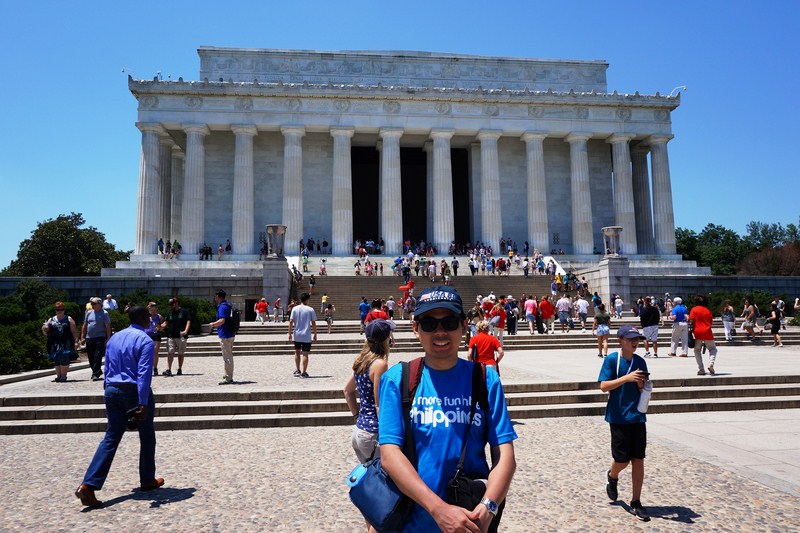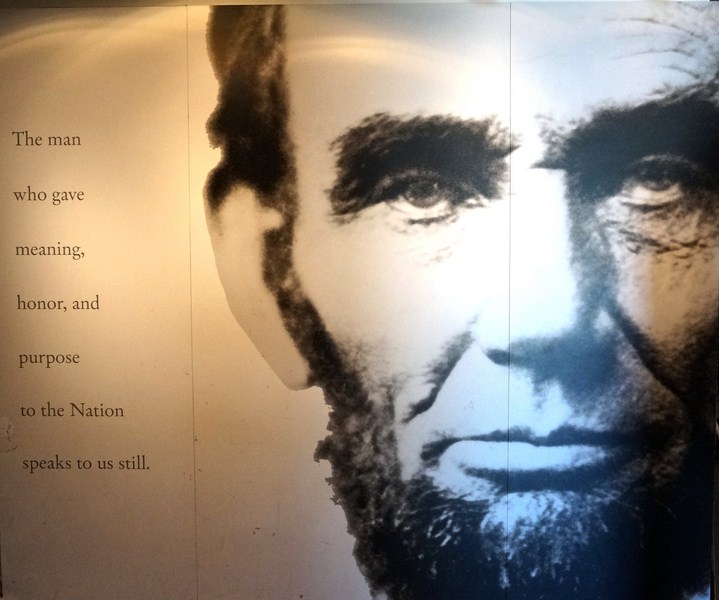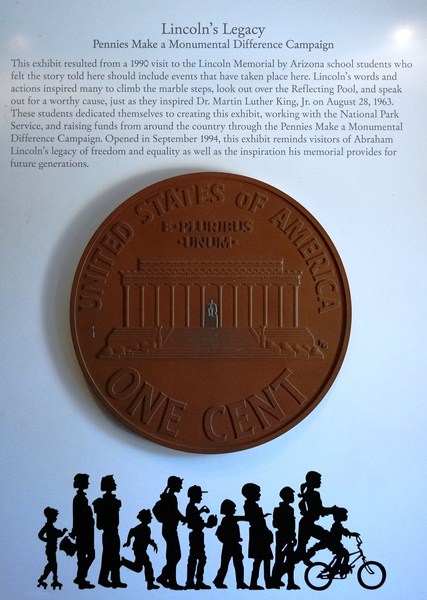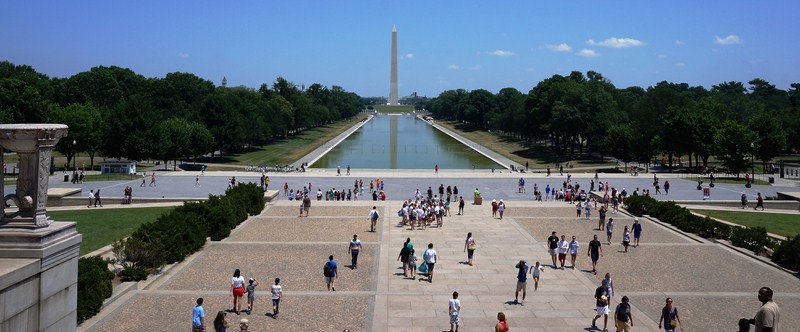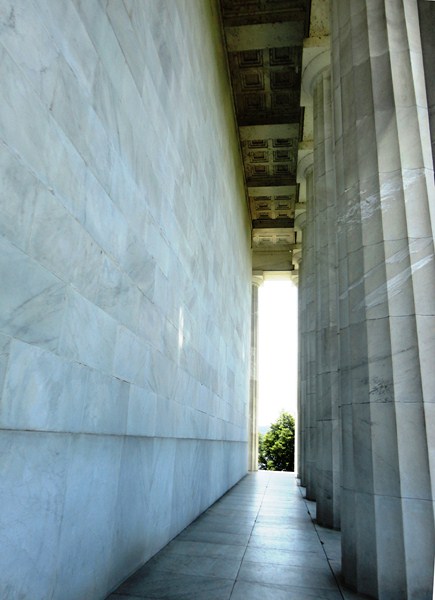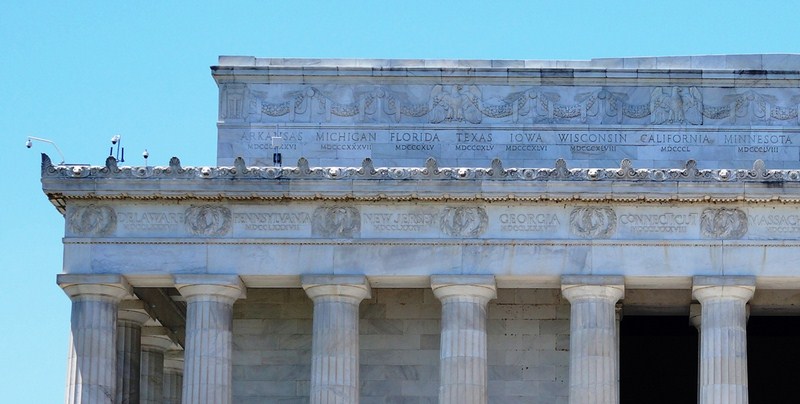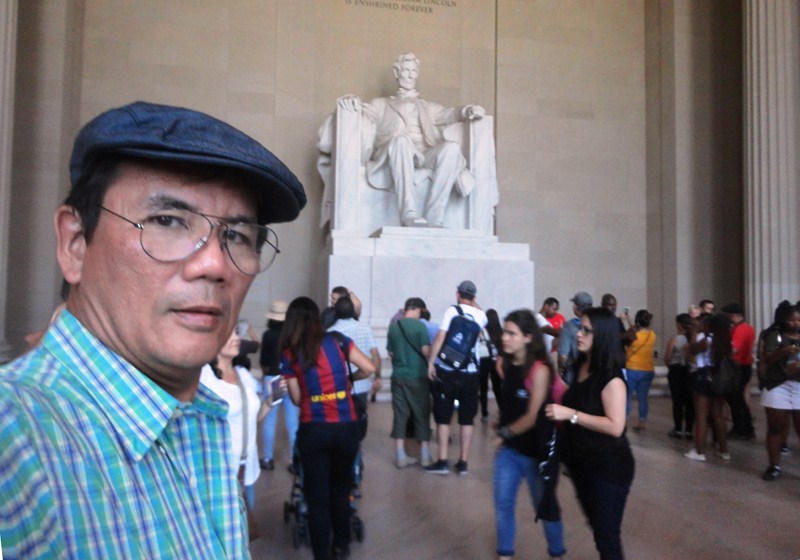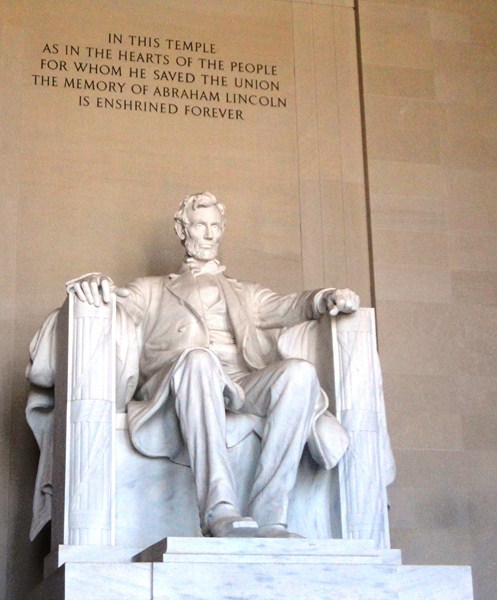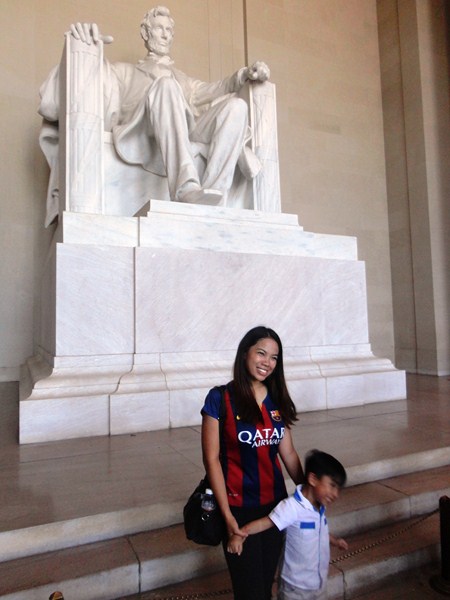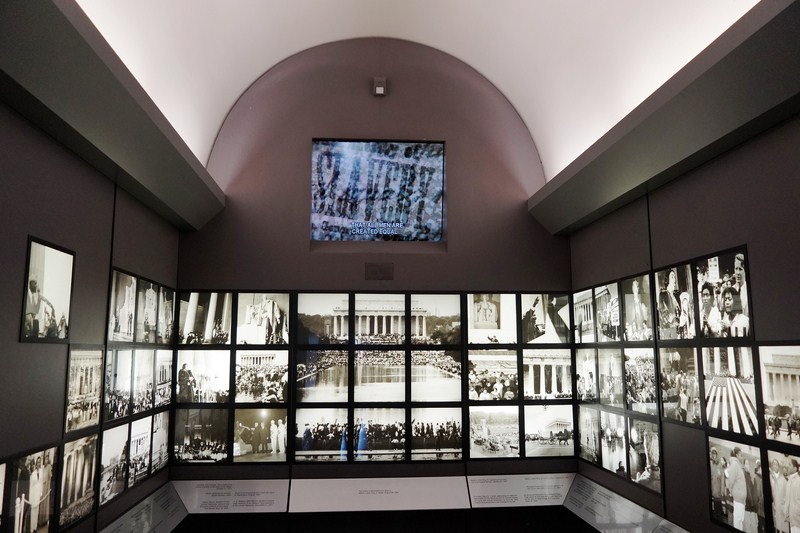The Lincoln Memorial, an iconic American national monument built to honor Abraham Lincoln, the 16th President of the United States, is located on the western end of the National Mall , Situated on the Washington Monument–Capitol axis, this Neo-Classical monument overlooks the Potomac River, across from the Washington Monument. Behind it is the bridge to Arlington National Cemetery. Dedicated in 1922, it is one of several monuments built to honor an American president.
Since the time of Lincoln’s death, demands for a fitting national memorial had been voiced. In 1868, three years after Lincoln’s assassination, the first public memorial (a statue by Lot Flannery) to Abraham Lincoln in Washington, D.C., was erected in front of the District of Columbia City Hall.
Here is the historical timeline of the statue’s construction:
- In 1867,Congress passed the first of many bills incorporating a commission to erect a monument for the sixteenth president but the matter lay dormant.
- At the start of the 20th century, under the leadership of Senator Shelby M. Cullom of Illinois, six separate bills were introduced in Congress for the incorporation of a new memorial commission. The first five bills, proposed in the years 1901, 1902, and 1908, met with defeat because of opposition from Speaker Joe Cannon. The sixth bill (Senate Bill 9449), introduced on December 13, 1910, passed.
- In 1911, the Lincoln Memorial Commission had its first meeting and U.S. President William H. Taft was chosen as the commission’s president. Progress continued at a steady pace.
- By 1913, Congress had approved of the Commission’s choice of design and location. With Congressional approval and a $300,000 allocation, the project got underway.
- On February 12, 1914, a dedication ceremony was conducted
- The following month, actual construction began.
- As late as 1920, the decision was made to substitute an open portal for the bronze and glass grille which was to have guarded the entrance.
- On May 30, 1922, Commission president William H. Taft (who was, by then, Chief Justice of the United States) dedicated the Memorial and presented it to Pres. Warren G. Harding, who accepted it on behalf of the American people. Lincoln’s only surviving son, 78-year-old Robert Todd Lincoln, was in attendance. Robert Russa Moton, an African American educator and author, was one of the speakers at the dedication.
Here are some interesting trivia regarding the memorial:
- In 2007, the American Institute of Architects (AIA) ranked the memorial as seventh, among 150 highest-ranked structures, in the AIA List of America’s Favorite Architecture.
- It has always been a major tourist attraction and, since 2010, approximately 6 million people visited the memorial annually.
- Like other monuments on the National Mall – including the nearby Vietnam Veterans Memorial, Korean War Veterans Memorial, and National World War II Memorial – the memorial is administered by the National Park Service under its National Mall and Memorial Parks
- The memorial’s columns, exterior walls and facade are all inclined slightly toward the building’s interior to compensate for a common feature of Ancient Greek architecture – perspective distortions which would otherwise make the memorial appear to bulge out at the top when compared with the bottom.
- Since the 1930s, the memorial has become a symbolically sacred center focused on race relations, especially for the Civil Rights Movement. In 1939, the Daughters of the American Revolution refused to allow Marian Anderson, the African-American contralto, to perform before an integrated audience at the organization’s Constitution Hall. Secretary of the Interior Harold L. Ickes, at the suggestion of Eleanor Roosevelt, the wife of Pres. Franklin D. Roosevelt, arranged for a performance, on Easter Sunday of that year, on the steps of the Lincoln Memorial to a live audience of 70,000 and a nationwide radio audience.
- Since October 15, 1966, the Memorial was listed on the National Register of Historic Places.
- The memorial grounds has been the site of many famous speeches, including Martin Luther King Jr.‘s historic “I Have a Dream” speech honoring the president who had issued the Emancipation Proclamation 100 years earlier. It was delivered on August 28, 1963, during the rally at the end of the March on Washington for Jobs and Freedom, which proved to be a high point of the American Civil Rights Movement. It is estimated that approximately 250,000 people came to the event. The D.C. police also appreciated the location because it was surrounded on three sides by water, so that any incident could be easily contained. On August 28, 1983, to reflect on progress in gaining civil rights for African Americans and to commit to correcting continuing injustices, crowds gathered again to mark the 20th anniversary of the Mobilization for Jobs, Peace and Freedom. In 2003, the spot on which King stood, on the landing 18 steps below Lincoln’s statue, was engraved in recognition of the 40th anniversary of the event.
- The Memorial is replete with symbolic elements. The states of the Union at the time of Lincoln’s death are represented by the 36 columns and the inscriptions (with the dates in which they entered the Union), separated by double wreath medallions in bas-relief, in a frieze above the colonnade. The 48 states in 1922 (the year of the Memorial’s dedication) are represented by the 48 stone festoons above the columns and inscriptions above the cornice, on the attic frieze. The murals inside portray principles seen as evident in Lincoln’s life: Freedom, Liberty, Immortality, Justice, and the Law on the south wall; Unity, Fraternity, and Charity on the north. Cypress trees, representing Eternity, are in the murals’ backgrounds.
- The statue has been at the center of two urban legends. Some claimed that the face of Gen. Robert E. Lee, looking back across the Potomac toward Arlington House, his former home (now within the bounds of Arlington National Cemetery), was carved onto the back of Lincoln’s head. The second popular urban legend is that Lincoln is shown using sign language to represent the president’s initials (his left hand shaped to form an “A” and his right hand to form an “L”). The National Park Service denies both legends.
- From 1959 (the 150th anniversary of Lincoln’s birth) to 2008, the United States one cent coin depicted the memorial, with statue visible through the columns, on the reverse side. The front bore a bust of Lincoln. The memorial also appears on the back of the U.S. five dollar bill. The front bears Lincoln’s portrait.
The Lincoln Memorial, as one of the most prominent American monuments, has been featured in books, films, and television shows that take place in Washington. By 2003, it had appeared in over 60 films. In 2009, Mark S. Reinhart compiled some short sketches of dozens of uses of the Memorial in film and television. As of 2017, according to the National Park Service, “Filming/photography is prohibited above the white marble steps and the interior chamber of the Lincoln Memorial.” Today, due to restrictive filming rules, many of the appearances of the Lincoln Memorial are actually digital visual effects.
Here a list of some of the movie and television films the memorial has appeared in:
- In the 1939 American political comedy-drama film Smith Goes to Washington, the statue and its inscription provide inspiration to freshman Senator Jefferson Smith, played by James Stewart, in a key scene. The Park Service did not want director Frank Capra to film at the Memorial, so he sent a large crew elsewhere as a distraction while a smaller crew filmed Stewart and Jean Arthur at the Memorial.
- In the science fiction film The Day the Earth Stood Still, the alien Klaatu visits the Memorial and is impressed by Lincoln’s words carved there.
- Planet of the Apes (2001 American science fiction film)
- X-Men: First Class (2011 American superhero film)
- In the 2011 American science fiction action film Transformers: Dark of the Moon, Megatron destroys the statue of Lincoln and then sits on the chair as a throne.
- In the 2016 horror movie The Purge: Election Year, the Lincoln Memorial is shown with dead and burning bodies on the steps and the columns defaced with giant letters that spell out “PURGE,” written in human blood.
- In the Line of Fire (1993 American political thriller film)
- In the 2004 American adventure film National Treasure, while sitting on the steps of the Memorial, the main characters discuss the possibility of stealing the Declaration of Independence
- In the 2009 American adventure fantasy comedy film Night at the Museum: Battle of the Smithsonian, the statue of Lincoln helps defeat the Horus warriors
- In the” Lisa Goes to Washington” episode of The Simpsons
- In the 1994 American epic comedy-drama film Forrest Gump, Forrest (Tom Hanks) delivers a speech standing on a podium in front of the Memorial facing the reflecting pool
- In the 2013 American political action thriller film White House Down, U.S. President (Jamie Foxx) requests a fly-by of the Lincoln Memorial, at both the beginning and the end of the movie to pay homage to his hero.
The Memorial, designed by Illinois-born architect Henry Bacon, in the form of a classic Greek Doric temple, features Yule marble from Colorado. The structure measures 57.8 m. (189.7 ft.) by 36.1 m. (118.5 ft.) and is 30 m. (99 ft.) high. It is surrounded by a peristyle of 36 fluted Doric columns, one for each of the 36 states in the Union at the time of Lincoln’s death, and two columns in-antis at the entrance behind the colonnade. Each of the 13 m. (44 ft.) high columns, with a base diameter of 2.3 m. (7.5 ft.), column, is built from 12 drums including the capital.
Above the colonnade is a frieze. The cornice, composed of a carved scroll regularly interspersed with projecting lions’ heads, is ornamented, along the upper edge, with palmetto cresting. A bit higher is a garland, joined by ribbons and palm leaves, and supported by the wings of eagles. All ornamentation on the friezes and cornices was done by Ernest C. Bairstow.
The Memorial’s 13 to 20 m. (44 to 66 ft.) deep concrete foundation, constructed by M. F. Comer and Company and the National Foundation and Engineering Company, is encompassed by a 57 by 78 m. (187 by 257 ft.) rectangular, 4.3 m. (14 ft.) high granite retaining wall.
The main steps leading up to the shrine on the east side, intermittently spaced with a series of platforms, begin at the edge of the shimmering Reflecting Pool, rise to the Lincoln Memorial Circle roadway surrounding the edifice, then to the main portal. As they approach the entrance, the steps are flanked by two buttresses each crowned with a 3.4 m. (11-ft.) high tripod carved from pink Tennessee marble by the Piccirilli Brothers.
The Memorial’s interior is divided into three chambers by two rows of four 15 m. (50 ft.) high Ionic columns, each 1.7 m. (5.5 ft.) across at their base. The 18.3 m.(60 ft.) wide, 22.56 m. (74 ft.) deep, and 18.3 m. (60 ft.) high central chamber houses the statue of Lincoln while the north and south chambers display carved inscriptions of Lincoln’s second inaugural address and his Gettysburg Address, two well-known speeches by Lincoln.

Inscription of the Second Inaugural Address given March 4, 1865 by Lincoln barely one month before the end of the Civil War. Above it is the mural “Unity” done by Jules Guerin. The mural features the Angel of Truth joining the hands of two figures representing the North and South. Her protective wings cradle the arts of Painting, Philosophy, Music, Architecture, Chemistry, Literature, and Sculpture. Emerging from behind the music figure is a veiled image of the Future.
Pilasters, ornamented with fasces, eagles, and wreaths, border these inscriptions. Both inscriptions and adjoining ornamentation were done by Evelyn Beatrice Longman. Each inscription is surmounted by 18.3 by 3.7 m. (60 by 12 ft.) murals (“Unity,” above the Second Inaugural Address on the north wall, and “”Emancipation,” above the Gettysburg Address on the south chamber wall) by Jules Guerin. The murals’ paint incorporated kerosene and wax to protect the exposed artwork from fluctuations in temperature and moisture.
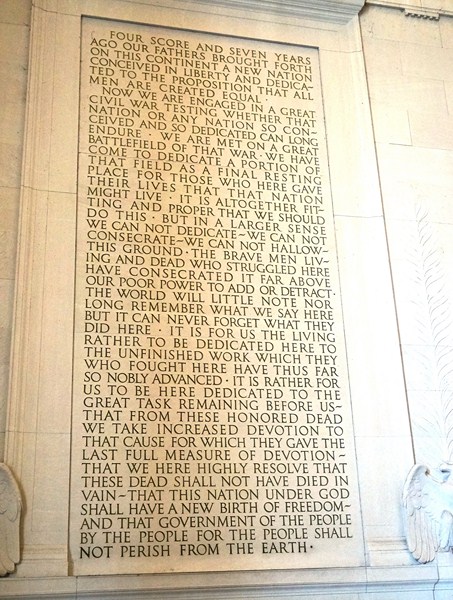
The inscription of the Gettysburg Address on the south chamber wall. The Gettysburg Address was given by Lincoln on April 19, 1863 in Gettysburg at the dedication of Soldiers’ National Cemetery.
Abraham Lincoln, 1920, the primary statue (of Georgia white marble) of the solitary figure of Lincoln sitting in contemplation, took four years to complete. It was carved by the Piccirilli Brothers under the supervision of the sculptor, Daniel Chester French.
The statue, originally designed to be 3.0 m. (10 ft.) tall, was, on further consideration, enlarged to 5.8 m. (19 ft.) tall, from head to foot (the scale being such that if Lincoln were standing, he would be 8.5 m. or 28 ft. tall), to prevent it from being overwhelmed by the huge chamber. The widest span of the statue corresponded to its height.
Lincoln’s arms rest on representations of Roman fasces. This subtle touch associates the statue with the Augustan (and imperial) theme (obelisk and funerary monuments) of the Washington Mall. Between two pilasters discretely bordering the statue (one on each side) and above Lincoln’s head, is engraved an epitaph of Lincoln by Royal Cortissoz.
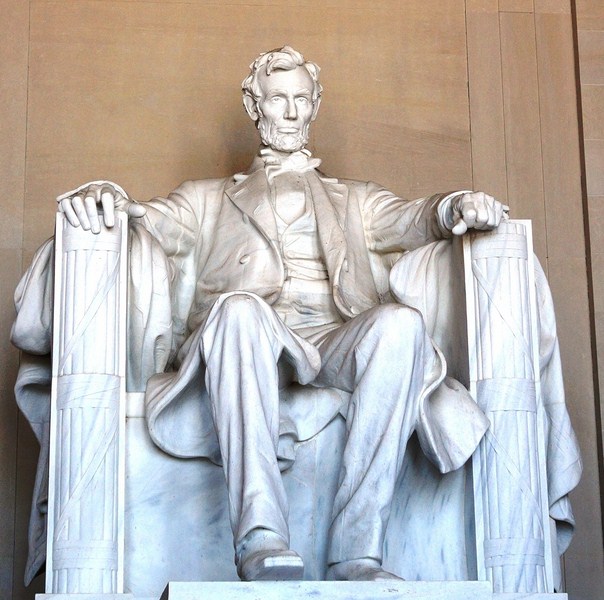
The Lincoln statue up close. The open hand represents compassion while the fist means decisiveness. The chair Lincoln is sitting on is Roman it is draped with the American flag.
The statue rests upon an oblong 3.0 m. (10 ft.) high, 4.9 m. (16 ft.) wide and 5.2 m. (17 ft.) deep pedestal of Tennessee marble, directly beneath which is a 10.5 m. (34.5 ft.) long, 8.5 m. (28 ft.) wide and 0.17 m. (6.5 in.) high platform of Tennessee marble. The statue weighed 159 tons (175 short tons) and was shipped in 28 pieces.
The ceiling, consisting of bronze girders ornamented with laurel and oak leaves, is set between panels of Alabama marble (saturated with paraffin to increase translucency). Bacon and French felt that the statue required even more light to supplement the natural light so, in 1929, they designed and installed metal slats in the ceiling to conceal floodlights, which could be modulated. In the 1970s, an elevator for handicapped was added.
Underneath the Lincoln Memorial are exhibits that provide information on the creation of the memorial and its famous subject.
Lincoln Memorial: 2 Lincoln Memorial Cir NW, Washington, D.C. 20037, USA. Open 24 hours. Rangers are on duty from 9:30 AM to 10 PM daily.
How to Get There: The easiest way to get to the Lincoln Memorial is via Metrorail (the nearest Metro stations are Foggy Bottom and Smithsonian, both on the Orange, Blue and Silver lines) or Metrobus (take the 32, 34 or 36 routes). Capital Bikeshare also has a dock (Daniel French Drive SW) nearby.


